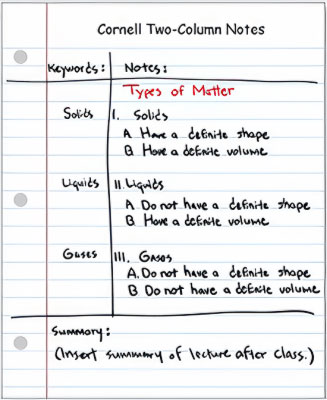Not sure about any of you, but I remember learning a neat technique for taking notes in school called Cornell Notes. This note-taking system is used by both professionals and students to improve their attention and understanding of information. In this Learning and Development Lab blog post, we will dive into all things Cornell Notes, including its history, structure, and how to use it most effectively.
A Brief History
The Cornell note-taking system was developed in the 1950s by Walter Pauk, a professor at Cornell University. Pauk designed this method to help students better organize their notes and enhance their learning experiences. Over the years, the Cornell method has gained popularity and is now considered one of the most effective note-taking strategies available.
Structure of the Cornell Note-Taking System
The Cornell method is widely recognized for its unique layout, which includes three main sections:
- The Note-Taking Area: This larger right-hand section is where you record the bulk of your information during lectures or readings. It is used to capture detailed notes, ideas, and concepts.
- The Cue Column: This narrow left-hand column is used for jotting down key points, questions, or prompts related to the notes taken. It serves as a quick reference for reviewing material later.
- The Summary Section: Located at the bottom of the page, this section allows you to review and consolidate the main ideas from your notes. Writing a brief summary helps reinforce your understanding and retention of the material.
Effective Use of the Cornell Method
To use the Cornell method effectively, it is important to actively engage with the material while taking notes. Here are some practical tips:
- During Lectures or Readings:
- Active Listening: Focus on understanding the material rather than transcribing everything. Write down main ideas, key concepts, and examples in the note-taking area.
- Use Abbreviations: Develop a system of abbreviations or symbols to help keep up with the pace of lectures.
- After Class:
- Review and Revise: Spend a few minutes after class reviewing your notes. Fill in any gaps, clarify points, and add additional insights.
- Create Cues: Generate questions or keywords in the Cue column that relate to your notes. This step is crucial for active recall during study sessions.
- Study Sessions:
- Self-Testing: Use the Cue column to quiz yourself. Cover the note-taking area and try to recall the details based on the cues.
- Summarization: Write a concise summary of the material at the bottom of the page to solidify your understanding.
- Digital Adaptation:
- Use Note-Taking Apps: Many digital note-taking applications, such as Notion, OneNote, and Evernote, can be formatted to mimic the Cornell layout, allowing for easy organization and access to your notes from anywhere.
- Collaboration:
- Group Study: Share and compare notes with classmates using the Cornell method. This collaborative approach can enhance understanding and fill in knowledge gaps.
Conclusion
The Cornell Method of note-taking is a powerful tool for improving your studying efforts and retaining important information. By incorporating this method into your note-taking routine, you can enhance your understanding of complex topics and increase your academic and professional performance. Give this method a try the next time you take notes!
This article is part of EMI’s Learning & Development Lab initiative, an effort to discover how AEC professionals best learn in order to create learning environments that truly transfer skills back to the job. You can join the L&D Lab LinkedIn Group here and join us in this effort.
About the Author:

Most recently, during his time working for the public sector, he has taken the role of Public Works Operations Manager. There he led quite a few public infrastructure rehabilitation projects and implemented new asset management technologies at a very young age. It is here that the passion for “fixing what’s broken” has developed.
We would love to hear any questions you might have or stories you might share about how you use Cornell Notes for learning and development.
Please leave your comments, feedback or questions in the section below.













